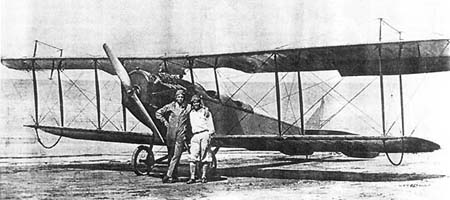PHILIPPINE
AIR SERVICE
1920
- 1921
Joseph
T.N. Suarez
8914
Clifford Avenue, Chevy Case, MD 20815

A
Philippine Air Service Jenny on the beach and runway at Camp Claudio
along
with Air Service pilots. Lt. Calvo is pictured on the left.
On
a cool April morning in 1920 at Camp Claudio near Manila on the Island
of Luzon, a wide, windswept beach that had been prepared as a runway was
being made ready for an historic flight. The skies were clear and the air
was clean and fresh with the smell that can only emanate from the ocean
breezes. The only sound was that of the occasional seagull. The sputter
and then hum of the well-tuned Curtiss Jenny engine, just warming up for
the morning's training flight, soon broke the morning's silence.
On
this day, Philippine aviation history was made. Lt. Leoncio Malinao, a
Philippine National Guard officer and flight cadet at the Curtiss School
of Aviation at Camp Claudio, was given his authorization to fly solo in
the Jenny. He climbed into the cockpit of his airplane, strapped in, checked
his instrumentation, and gave his instructor a "thumbs up". With that,
he revved his Curtiss OX-5 engine with its distinctive clatter and began
slowly moving his machine down the runway, gradually picking up speed until
its wheels cleared the packed sand and gracefully became airborne. Lt.
Malinao flew toward Cavite and back along Pasay before landing. With this
flight, he became the very first Filipino military pilot and his solo flight
was the first by any Filipino who had not had any flight training outside
the Islands.
Early
aviation in the Philippines differed little from early aviation in other
parts of the world. In each case these pioneers of flight had a distinct
blend of braver and exceptional daring. These early pilots, so far from
the cradle of aviation, needed extra courage, a sense of adventure, and
an innate ability to master the techniques so that they could almost become
one with their aircraft These first Filipino National Guard and Constabulary
pilots would be the first of their fellow countrymen to take to the skies
and be the first to be trained to fly.
With
the end of the Spanish-American War in 1898 the United States acquired,
for the first time, a number of overseas territories and began to expand
its influence and reach around the world. No longer was it limited to protecting
its interests within the continental boundaries. It now had interests to
protect and assets to defend in the far reaches of the world, including
the Philippine and Hawaiian Islands. In the case of the Philippines and
Hawaii, their sheer distance from the U.S. mainland was problematic in
maintaining a strong influence to protect and maintain military and economic
interests.
Aviation
in the Philippines closely paralleled the growth and importance of flight
in the United States and around the world. The Insular Government of the
Philippines predicted that aviation would some day bring great commercial
and economic benefits to the Islands. Aviation also provided the Philippines
with an opportunity to connect the more than 7,000 islands in the archipelago
by providing transportation, communications, and airmail delivery.
Photos
from the collection of Lt. Wenceslao Abolencia via Maj F. Vasallo and Capt.
Alberto Anido unless noted.
|

